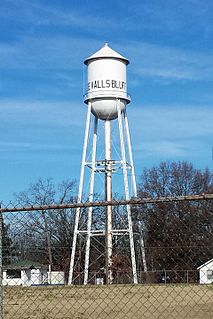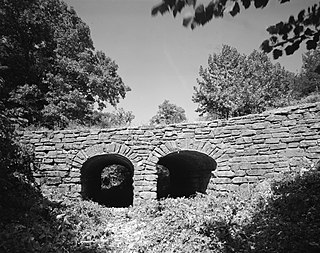
Highway 103 is a designation for two north–south state highways in Arkansas. One segment begins in Clarksville in the Arkansas River Valley and runs north to the Ozark National Forest. A second route runs through a sparsely populated segment of the Ozark Mountains between the Buffalo National River and Highway 21 near the Missouri state line.

The Hackensack Water Company Complex is a set of historic buildings in Weehawken, New Jersey, registered in the U.S. National Register of Historic Places. The Hackensack Water Company, a predecessor of Suez North America, developed water supply and storage in northeastern New Jersey from the 1870s to the 1970s, initially to provide service to the city of Hackensack and the towns of North Hudson. Originally its headquarters and major facilities were located at Hackensack, in Bergen County. Under Robert W. de Forest, who ran the Hackensack Water Company for 46 years beginning in 1881, the company constructed new facilities and moved its headquarters to Weehawken in Hudson County, setting up offices in a brick water tower, part of the present complex.

Lockesburg Waterworks are a water storage and distribution facility at the junction of Hickory and Azalea Streets in Lockesburg, Arkansas. The facility consists of a water tower and three water storage sheds, of which the tower was built in 1936 with funding assistance from the Public Works Administration, a Depression-era works project. The older shed was built in 1945, and the second was built in 1990. The tower is a metal structure with four legs supported and stabilized by cross bracing, with a metal tank at the top which is sheltered by a conical roof. The oldest shed is a modest square brick structure at the center of the complex, while the 1990 shed is located at the southwest corner of the property.

The Cove Creek Bridge is a historic bridge, carrying Arkansas Highway 309 across Cove Creek, south of the hamlet of Corley, Arkansas in the Ozark-St. Francis National Forest. It is a two-span closed-spandrel masonry arch structure, with each span measuring 13 feet (4.0 m) and an overall structure length of 26 feet (7.9 m). It is built entirely out of stone, with a concrete and asphalt deck, and concrete barriers at the sides. It was built in 1936 with funding support from the Works Progress Administration.

The Washington County Courthouse is the name of a current courthouse and that of a historic one in Fayetteville, Arkansas, the county seat of Washington County. The historic building, built in 1905, was listed on the National Register of Historic Places in 1972. The historic courthouse is the fifth building to serve Washington County, with the prior buildings located on the Historic Square where the Old Post Office is today. The building is one of the prominent historic buildings that compose the Fayetteville skyline, in addition to Old Main.

The Allen Hazen Water Tower, also known as the Municipal Water Tower, is a historic structure located on the west side of Des Moines, Iowa, United States. It was listed on the National Register of Historic Places in 2004.

The Monette Water Tower is a historic structure located at the junction of Arkansas Highway 139 and Texie Avenue in Monette, Arkansas. It was built in 1936 by the Chicago Bridge & Iron Company in conjunction with the Public Works Administration as part of a project to improve the area's water supply. The Monette Water Tower is considered a good example of a 1930s-era elevated steel water tank. It was added to the National Register of Historic Places in 2008, as part of a multiple-property listing that included numerous other New Deal-era projects throughout Arkansas.

The Monette Water Tower is a historic elevated steel water tower located in Hartford, Arkansas. It was built in 1936 by the Chicago Bridge & Iron Company in conjunction with the Public Works Administration as part of a project to improve the local water supply. The project was one of 124 similar projects in the state funded by the PWA. It was added to the National Register of Historic Places in 2008, as part of a multiple-property listing that included numerous other New Deal-era projects throughout Arkansas.

The McCrory Waterworks is a historic site located in McCrory, Arkansas. It contains an elevated steel water tower, built in 1936 by the Chicago Bridge & Iron Company in conjunction with the Public Works Administration, which provided $39,497 in aid for the construction of the waterworks, which included the water tower, tank, and water shed. The site was added to the National Register of Historic Places in 2007, as part of a multiple-property listing that included numerous other New Deal-era projects throughout Arkansas.

The De Valls Bluff Waterworks is a historic public water supply facility at Rumbaugh and Hazel Streets in De Valls Bluff, Arkansas. It contains a 1930s-era elevated steel water tower, built in 1936 by the Pittsburgh-Des Moines Steel Company in conjunction with the Public Works Administration as part of a project to improve the local water supply. It was added to the National Register of Historic Places in 2007, as part of a multiple-property listing that included numerous other New Deal-era projects throughout Arkansas. The property also contains several non-contributing buildings, including a shed, aeration chamber and water tank.

The Monroe Water Tower is a historic water tower built in 1889 in Monroe, Wisconsin. It was added to the National Register of Historic Places in 2005.

The Bearden Water Works are a historic public water works facility in Bearden, Arkansas, United States. It is located behind Bearden's city hall, at the corner of North 2nd Street and North Cedar Street, and consists of a water tower, two well houses, and a concrete holding tank. The facility was funded in 1936 by the Public Works Administration (PWA), and is the only PWA-built water works left in the county.

The Phillips County Penal Farm Historic District encompasses a former prison facility in Phillips County, Arkansas. It is located on the east side of County Road 353, south of United States Route 49, about halfway between Helena-West Helena and Marvell. The complex consists of three concrete structures, a water tower, and a concrete foundation pad. The main building is a cast concrete structure, two stories in height, with Plain Tradition and International styling, while the other two buildings are single-story concrete block structures. These, and the water tower, were built c. 1935–37 with funding from the Works Progress Administration, and served as a penal facility until 1973. The property is now vacant and abandoned.

The Hughes Water Tower is located on Church Street in Hughes, Arkansas. It is a metal structure consisting of four legs, sloping inward as they rise, which support a roughly cylindrical tower with bowl-shaped bottom and a conical roof. The legs are joined by reinforcing rods to provide stability. A large metal pipe connects the tank to water facilities on the ground, and there is a walkway with railing around the tank. The tower was built in 1936 by the Chicago Bridge and Iron Works Company with funding from the Public Works Administration.

The Keiser Water Tower is a historic waterworks facility at Water and East Main Street in Keiser, Arkansas. It is an open metal structure, several stories high, with a roughly cylindrical tank at the top, and a rising through the center to provide water to the tank. A ladder providing access to the tank is fixed to one of the legs, and there is a circular catwalk with railing around the tank. The structure was built in 1936 with funding from the Public Works Administration, and is one of the few Depression-era structures left in the small community.

The W. D. Crawford House is a historic house in rural central Carroll County, Arkansas. It is located on the east side of County Road 643, east of Berryville, near the small rural community of Cisco. It is a two-story stone structure, with a hip roof that rises to a cupola at the peak. The house was built c. 1900 by W. D. Crawford, a graduate of the law school of the University of Arkansas at Fayetteville, who used the building as a home and school until 1904, when he founded the Ozark Normal School at Green Forest. Crawford would remain a constant presence in the educational systems of the region until his death in 1952.

The Mo-Ark Baptist Academy is a historic religious school building in Blue Eye, Arkansas. It is located just south of the western end of Park Street, not far from the state line with Blue Eye, Missouri. It is a large T-shaped two-story brick building with a hip roof, built in 1918 to house what was initially called the Carroll County Institute. At first funded by the Arkansas Baptist Convention and the Southern Baptist Convention, it eventually also received funding from Missouri Baptists, and was renamed. The school was later expanded to include both boys and girls dormitories; the latter still stands nearby. The school closed its doors in 1931; the building was used by the Green Forest School District as an elementary school into the 1950s, and has since seen intermittent use as a community center.

The Mulladay Hollow Bridge is a stone arch bridge in rural Carroll County, Arkansas. It carries County Road 204 across Mulladay Hollow Creek, near the southwestern tip of Lake Leatherwood It has two spans, and is built out of roughly square and semi-coursed fieldstone. The arches are elliptical in shape, 9 feet (2.7 m) in height and 9.5 feet (2.9 m) wide, with nearly-square voussoirs forming the arches. The barrels of the arches are skewed with respect to the spandrels, and the wing walls are slightly curved. The roadway carried by the bridge is 30 feet (9.1 m) wide, and the total length of the structure is 120 feet (37 m). The bridge was built with Works Progress Administration funding as part of the development of Lake Leatherwood as a recreation area.

The Tuckerman Water Tower is a historic waterworks facility at the south end of Front Street in Tuckerman, Arkansas. It is a tall metal structure, with four latticed legs, braced with rods and sloping inward, to support a water tank that is bowl-shaped at the bottom and topped by a conical roof. A pipe traverses the center of the tower for the movement of water to and from the tank. Built in 1935 with funding support from the Depression-era Public Works Administration (PWA), it is the only remaining PWA tower of its type in the county.

The Mountain View Waterworks are a historic public water supply system in Mountain View, Arkansas. The facilities consist of a tower and well house, located at the junction of Gaylor and King Streets. The tower is a metal structure with four legs, reinforced by diagonal latticework members, topped by a water tank with a bowl-shaped bottom and a conical roof. A large pipe connects from the bottom of the tank to the well house, a square fieldstone structure. These facilities were built in 1936–37 with funding from the Public Works Administration, and were still in use at the time of the property's listing on the National Register of Historic Places in 2006.






















